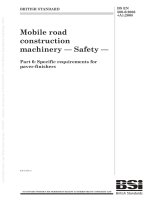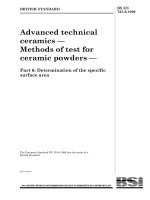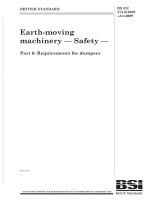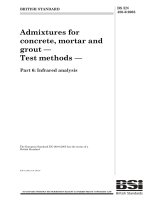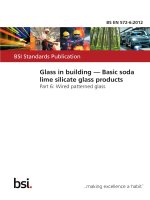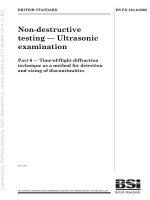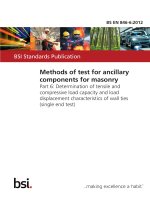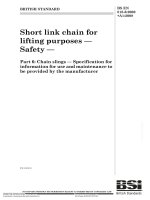Bsi bs en 62282 6 300 2013
Bạn đang xem bản rút gọn của tài liệu. Xem và tải ngay bản đầy đủ của tài liệu tại đây (2.69 MB, 108 trang )
BS EN 62282-6-300:2013
BSI Standards Publication
Fuel cell technologies
Part 6-300: Micro fuel cell
power systems — Fuel cartridge
interchangeability
BS EN 62282-6-300:2013 BRITISH STANDARD
National foreword
This British Standard is the UK implementation of EN 62282-6-300:2013.
It is identical to IEC 62282-6-300:2012. It supersedes BS EN 62282-6-300:2009
which is withdrawn.
The UK participation in its preparation was entrusted to Technical
Committee GEL/105, Fuel cell technologies.
A list of organizations represented on this committee can be obtained on
request to its secretary.
This publication does not purport to include all the necessary provisions of
a contract. Users are responsible for its correct application.
© The British Standards Institution 2013.
Published by BSI Standards Limited 2013
ISBN 978 0 580 77430 0
ICS 27.070
Compliance with a British Standard cannot confer immunity from
legal obligations.
This British Standard was published under the authority of the
Standards Policy and Strategy Committee on 31 July 2013.
Amendments/corrigenda issued since publication
Date Text affected
EUROPEAN STANDARD BS EN 62282-6-300:2013
NORME EUROPÉENNE
EUROPÄISCHE NORM EN 62282-6-300
ICS 27.070 July 2013 Supersedes EN 62282-6-300:2009
English version
Fuel cell technologies -
Part 6-300: Micro fuel cell power systems -
Fuel cartridge interchangeability
(IEC 62282-6-300:2012)
Technologies des piles à combustible - Brennstoffzellentechnologien -
Partie 6-300: Systèmes à micro-piles à Teil 6-300: Mikrobrennstoffzellen-
combustible - Energiesysteme -
Interchangeabilité de la cartouche de Austauschbarkeit der Brennstoffkartusche
combustible (IEC 62282-6-300:2012)
(CEI 62282-6-300:2012)
This European Standard was approved by CENELEC on 2013-01-17. CENELEC members are bound to comply
with the CEN/CENELEC Internal Regulations which stipulate the conditions for giving this European Standard
the status of a national standard without any alteration.
Up-to-date lists and bibliographical references concerning such national standards may be obtained on
application to the CEN-CENELEC Management Centre or to any CENELEC member.
This European Standard exists in three official versions (English, French, German). A version in any other
language made by translation under the responsibility of a CENELEC member into its own language and notified
to the CEN-CENELEC Management Centre has the same status as the official versions.
CENELEC members are the national electrotechnical committees of Austria, Belgium, Bulgaria, Croatia, Cyprus,
the Czech Republic, Denmark, Estonia, Finland, Former Yugoslav Republic of Macedonia, France, Germany,
Greece, Hungary, Iceland, Ireland, Italy, Latvia, Lithuania, Luxembourg, Malta, the Netherlands, Norway, Poland,
Portugal, Romania, Slovakia, Slovenia, Spain, Sweden, Switzerland, Turkey and the United Kingdom.
CENELEC European Committee for Electrotechnical Standardization
Comité Européen de Normalisation Electrotechnique
Europäisches Komitee für Elektrotechnische Normung
Management Centre: Avenue Marnix 17, B - 1000 Brussels
© 2013 CENELEC - All rights of exploitation in any form and by any means reserved worldwide for CENELEC members.
Ref. No. EN 62282-6-300:2013 E
BS EN 62282-6-300:2013
EN 62282-6-300:2013 - 2 -
Foreword
The text of document 105/370/CDV, future edition 2 of IEC 62282-6-300, prepared by IEC TC 105, "Fuel
cell technologies" was submitted to the IEC-CENELEC parallel vote and approved by CENELEC as
EN 62282-6-300:2013.
The following dates are fixed:
• latest date by which the document has (dop) 2014-01-05
2016-01-17
to be implemented at national level by
publication of an identical national
standard or by endorsement
• latest date by which the national (dow)
standards conflicting with the
document have to be withdrawn
This document supersedes EN 62282-6-300:2009.
EN 62282-6-300:2013 includes the following significant technical changes with respect to
EN 62282-6-300:2009:
a) The status of designs yet to be included in the standard is clarified.
b) Type A to D interchangeable connectors are updated, and Type E is added.
c) The procedures, criteria and figures of the type tests for interchangeable connectors are updated to
ensure they produce accurate and consistent results.
d) The fuel quality requirements are updated including the test procedures for residue and impurities.
Attention is drawn to the possibility that some of the elements of this document may be the subject of
patent rights. CENELEC [and/or CEN] shall not be held responsible for identifying any or all such patent
rights.
Endorsement notice
The text of the International Standard IEC 62282-6-300:2012 was approved by CENELEC as a European
Standard without any modification.
In the official version, for Bibliography, the following notes have to be added for the standards indicated:
IEC 61032 NOTE Harmonized as EN 61032.
IEC 62282-6-200 NOTE Harmonized as EN 62282-6-200.
BS EN 62282-6-300:2013
- 3 - EN 62282-6-300:2013
Annex ZA
(normative)
Normative references to international publications
with their corresponding European publications
The following documents, in whole or in part, are normatively referenced in this document and are
indispensable for its application. For dated references, only the edition cited applies. For undated
references, the latest edition of the referenced document (including any amendments) applies.
NOTE When an international publication has been modified by common modifications, indicated by (mod), the relevant EN/HD
applies.
Publication Year Title EN/HD Year
IEC 60950-1 - EN 60950-1 -
IEC 62282-6-100 2010 Information technology equipment - Safety - EN 62282-6-100 2010
+ corr. December 2011 Part 1: General requirements
IEC 62282-6-200 - EN 62282-6-200 -
Fuel cell technologies -
ISO 1302 2002 Part 6-100: Micro fuel cell power systems - EN ISO 1302 2002
Safety
Fuel cell technologies -
Part 6-200: Micro fuel cell power systems -
Performance test methods
Geometrical Product Specifications (GPS) -
Indication of surface texture in technical
product documentation
– 2 – BS EN 62282-6-300:2013
62282-6-300 IEC:2012
CONTENTS
INTRODUCTION ..................................................................................................................... 8
1 Scope...............................................................................................................................9
2 Normative references ..................................................................................................... 10
3 Terms and definitions ..................................................................................................... 10
4 Fuel connectors .............................................................................................................. 13
4.1 Basic requirements................................................................................................ 13
4.1.1 Safety........................................................................................................ 13
4.1.2 Safety of connectors during connecting, fueling and removing ...................14
4.2 Construction and actuation requirements...............................................................15
4.2.1 General ..................................................................................................... 15
4.2.2 Connector sealing......................................................................................15
4.2.3 Connector sequence..................................................................................15
4.2.4 Mechanical keys ........................................................................................ 15
4.2.5 Material requirement..................................................................................15
4.3 Interchangeable fuel connectors ............................................................................ 15
4.3.1 General ..................................................................................................... 15
4.3.2 Type A....................................................................................................... 16
4.3.3 Type B....................................................................................................... 23
4.3.4 Type C ...................................................................................................... 30
4.3.5 Type D ...................................................................................................... 36
4.3.6 Type E....................................................................................................... 42
4.4 Type tests for interchangeable fuel connectors ...................................................... 47
4.4.1 Test types ................................................................................................. 47
4.4.2 Mechanical strength requirement for interchangeable fuel connectors .......48
4.4.3 Test parameters ........................................................................................ 48
4.4.4 Classification of cartridge size and connector strength ..............................49
4.4.5 Test fixtures .............................................................................................. 49
4.4.6 Forces expected in normal operation and in foreseeable misuse (f1
and f2).......................................................................................................50
4.4.7 Number of samples....................................................................................51
4.4.8 Laboratory conditions ................................................................................52
4.4.9 Type tests ................................................................................................. 52
5 Fuel cartridge ................................................................................................................. 79
5.1 Fuel concentrations ............................................................................................... 79
5.2 Cartridge pressure................................................................................................. 79
5.3 Cartridge capacity, size and shape ........................................................................ 79
5.3.1 Cartridge size and shape ........................................................................... 79
5.3.2 Cartridge capacity and usable fuel determination.......................................82
5.4 Maximum discharge pressure ................................................................................84
5.5 Fuel quality ........................................................................................................... 87
5.5.1 General requirements ................................................................................87
5.5.2 Fuel quality requirements ..........................................................................87
5.5.3 Test sample...............................................................................................88
5.5.4 Test procedure to measure the residue......................................................88
5.5.5 Impurities test............................................................................................ 89
BS EN 62282-6-300:2013 – 3 –
62282-6-300 IEC:2012
5.5.6 Test set-up for impurities test with fuel cell operation ................................91
6 Marking .......................................................................................................................... 94
6.1 Cartridge marking.................................................................................................. 94
6.2 MFC power unit or electronic device marking ........................................................95
6.3 User information required in the manual or on the packaging ................................96
Annex A (informative) Calculations of f1, f2, and maximum discharge pressure ...................97
Annex B (informative) Test fixtures .................................................................................... 100
Bibliography........................................................................................................................ 103
Figure 1 – MFC power system block diagram ........................................................................10
Figure 2 – Fuel cartridge types ............................................................................................. 12
Figure 3 – MFC power unit side connector design (cross-sectional view) ..............................16
Figure 4 – MFC power unit side connector design (front-elevational view) ............................16
Figure 5 – Seal surface area design for MFC power unit side connector (cross-
sectional view) ...................................................................................................................... 17
Figure 6 – Cartridge space for satellite cartridge (cross-sectional view) ................................18
Figure 7 – Cartridge space for insert cartridge (cross-sectional view) ..................................19
Figure 8 – Mechanical key (wide and 2-key type) .................................................................. 20
Figure 9 – Mechanical key (narrow and 3-key type) .............................................................. 20
Figure 10 – Mechanical key variation with key number (front-elevational view) .....................20
Figure 11 – Connector retainer (unlocked) ............................................................................22
Figure 12 – Connector retainer (maximum set-back: locked) .................................................22
Figure 13 – MFC power unit side connector design (cross-sectional view) ............................24
Figure 14 – MFC power unit side connector design (front-elevational view)..........................24
Figure 15 – Cartridge space (cross-sectional view) ..............................................................25
Figure 16 – Mechanical keys................................................................................................. 26
Figure 17 – Connector retainer (cross-sectional view before connection) ..............................28
Figure 18 – Connector retainer (front-elevational view before connection) ............................28
Figure 19 – Connector retainer (cross-sectional view when retained) ....................................28
Figure 20 – Connector retainer (front-elevational view when retained) .................................28
Figure 21 – Connector retainer engaged (cross-sectional view) ............................................29
Figure 22 – MFC power unit side connector design (cross-sectional view) ............................31
Figure 23 – MFC power unit side connector design (front-elevational view)...........................31
Figure 24 – Cartridge space (cross-sectional view) ...............................................................32
Figure 25 – Mechanical key (cross-sectional view)...............................................................33
Figure 26 – Mechanical key (front-elevational view) ..............................................................33
Figure 27 – Mechanical key variation with key number ..........................................................33
Figure 28 – Connector retainer (cross-sectional view)...........................................................34
Figure 29 – MFC power unit side connector design (cross-sectional view) ...........................36
Figure 30 – MFC power unit side connector design (front-elevational view)..........................36
Figure 31 – Cartridge space for insert cartridge (cross-sectional view)..................................37
Figure 32 – Mechanical key (cross-sectional view)...............................................................38
Figure 33 – Mechanical key (front-elevational view) .............................................................38
Figure 34 – Mechanical key variation with key number ..........................................................39
– 4 – BS EN 62282-6-300:2013
62282-6-300 IEC:2012
Figure 35 – Connector retainer (cross-sectional view)...........................................................40
Figure 36 – Connector retainer (front-elevational view) ........................................................40
Figure 37 – MFC power unit side connector design ...............................................................42
Figure 38 – Seal surface area design for MFC power unit side connector (cross-
sectional view) ...................................................................................................................... 43
Figure 39 – Cartridge space for satellite cartridge (cross-sectional view) ..............................44
Figure 40 – Cartridge space for insert cartridge (cross-sectional view)..................................45
Figure 41 – Connector retainer ............................................................................................. 46
Figure 42 – Flow chart for connector type tests – Compression test for proper
combination and correct orientation in normal operation on a manufacturer’s cartridge
or a manufacturer’s end use MFC device ..............................................................................53
Figure 43 – Flow chart for connector type tests – Compression test for proper
combination and incorrect orientation in normal operation on a manufacturer’s
cartridge or a manufacturer’s end use MFC device ...............................................................55
Figure 44 – Flow chart for connector type tests – Compression test for proper
combination and incorrect orientation in foreseeable misuse on a manufacturer’s
cartridge or a manufacturer’s end use MFC device ...............................................................57
Figure 45 – Flow chart for connector type tests – Compression test for improper
mechanical key combination in normal operations on a manufacturer’s cartridge or a
manufacturer’s end use MFC device ..................................................................................... 59
Figure 46 – Flow chart for connector type tests – Compression test for improper
mechanical key combination in foreseeable misuse on a manufacturer’s cartridge or a
manufacturer’s end use MFC device ..................................................................................... 61
Figure 47 – Flow chart for connector type tests – Tensile test in normal operations on a
manufacturer’s cartridge or a manufacturer’s end use MFC device .......................................63
Figure 48 – Flow chart for connector type tests – Tensile test in foreseeable misuse on
a manufacturer’s cartridge or a manufacturer’s end use MFC device ....................................65
Figure 49 – Flow chart for connector type tests – Torsion test in normal operations on
a manufacturer’s cartridge or a manufacturer’s end use MFC device ....................................67
Figure 50 – Flow chart for connector type tests – Torsion test in foreseeable misuse on
a manufacturer’s cartridge or a manufacturer’s end use MFC device ....................................69
Figure 51 – Flow chart for connector type tests – Bending test in normal operations on
a manufacturer’s cartridge or a manufacturer’s end use MFC device ....................................71
Figure 52 – Flow chart for connector type tests – Bending test in foreseeable misuse
on a manufacturer’s cartridge or a manufacturer’s end use MFC device................................73
Figure 53 – Flow chart for connector type tests – Drop test in foreseeable misuse on a
manufacturer’s cartridge or a manufacturer’s end use MFC device .......................................76
Figure 54 – Flow chart for connector type tests – Vibration test in normal operations on
a manufacturer’s cartridge or a manufacturer’s end use MFC device ....................................78
Figure 55 – Prismatic cartridge ............................................................................................. 79
Figure 56 – Cylindrical cartridge ........................................................................................... 81
Figure 57 – Test diagram – Usable fuel measurement for pump-assisted discharging
cartridge (option 1) ............................................................................................................... 83
Figure 58 – Test diagram – Usable fuel measurement for pump-assisted discharging
cartridge (option 2) ............................................................................................................... 83
Figure 59 – Test diagram – Usable fuel measurement for non-pump assisted
discharging cartridge ............................................................................................................ 84
Figure 60 – Test diagram – Usable fuel measurement for pressurized cartridge ....................84
Figure 61 – Flow chart for maximum discharge pressure test ................................................86
Figure 62 – Test apparatus ................................................................................................... 92
BS EN 62282-6-300:2013 – 5 –
62282-6-300 IEC:2012
Figure 63 – Test cell construction drawing ............................................................................ 92
Figure 64 – Exploded view of test cell ................................................................................... 93
Figure 65 – Endplate and its flow channel design.................................................................. 93
Figure 66 – Types of fuel cartridges ...................................................................................... 95
Figure B.1 – Device test fixture for cartridge testing of 4.4.9 ............................................... 100
Figure B.2 – Device test fixture for cartridge testing of 5.3.2 and 5.4 .................................. 101
Figure B.3 – Cartridge test fixture for device testing of 4.4.9 ............................................... 102
Table 1 – Dimension and tolerance for MFC power unit side connector.................................17
Table 2 – Dimension of space for satellite cartridge in MFC power unit .................................18
Table 3 – Dimension for insert cartridge space in MFC power unit ........................................19
Table 4 – Key location and dimension with tolerance for mechanical key ..............................21
Table 5 – Dimension and tolerance for connector retainer on the MFC power unit side .........22
Table 6 – Dimension and tolerance for MFC power unit side connector.................................24
Table 7 – Dimension and tolerance .......................................................................................25
Table 8 – Key location and dimension with tolerance for mechanical key ..............................26
Table 9 – Dimension and tolerance for connector retainer on the MFC power unit ...............29
Table 10 – Dimension and tolerance for MFC power unit side connector ...............................31
Table 11 – Dimension and tolerance for cartridge space within MFC power unit....................32
Table 12 – Key location and dimension with tolerance for mechanical key ............................34
Table 13 – Dimension and tolerance for the MFC power unit side connector retainer ............35
Table 14 – Dimension and tolerance for MFC power unit side connector ...............................37
Table 15 – Dimension and tolerance for the cartridge space in MFC power unit ....................38
Table 16 – Dimension and tolerance for mechanical key .......................................................38
Table 17 – Key location for mechanical key ..........................................................................39
Table 18 – Dimension and tolerance for the MFC power unit side retainer ............................41
Table 19 – Dimension and tolerance for MFC power unit side connector ...............................43
Table 20 – Dimension of space for satellite cartridge in MFC power unit ...............................44
Table 21 – Dimensions for insert cartridge space in MFC power unit.....................................45
Table 22 – Dimension and tolerance for connector retainer on the MFC power unit side .......46
Table 23 – Interchangeable fuel connector type tests............................................................ 49
Table 24 – Classification of cartridge size and connector strength ........................................49
Table 25 – Device test fixture for cartridge testing ................................................................50
Table 26 – Cartridge test fixture for device testing ................................................................50
Table 27 – External forces expected in normal operation and foreseeable misuse ................51
Table 28 – Size and type of prismatic cartridge..................................................................... 80
Table 29 – Size and type of cylindrical cartridge ................................................................... 81
Table 30 – Test parameters for usable fuel determination .....................................................82
Table A.1 – Weight and size of typical cartridge.................................................................... 97
Table A.2 – Ergonomics data – Force by human hand or finger.............................................97
Table A.3 – Forces f1 and f2 for type tests............................................................................ 98
– 8 – BS EN 62282-6-300:2013
62282-6-300 IEC:2012
INTRODUCTION
The International Electrotechnical Commission (IEC) draws attention to the fact that it is
claimed that compliance with this document may involve the use of patents concerning fuel
connectors given in 4.3.1, 4.3.2, 4.3.3 and 4.3.4, patents concerning mechanical keys given in
4.2.3, and patents concerning fuel quality in 5.5.
IEC takes no position concerning the evidence, validity and scope of this patent right.
The holder of this patent right has assured the IEC that he is willing to negotiate licences
under reasonable and non-discriminatory terms and conditions with applicants throughout the
world. In this respect, the statement of the holder of this patent right is registered with IEC.
Information may be obtained from:
– Hitachi, Ltd., 1-1, Omika-cho 7-chome, Hitachi-shi, 319-1292 Japan
– Toyo Seikan Kaisha, Ltd., 3-1 Uchisaiwaicho 1-chome, Tokyo 100-8522 Japan
– Toshiba Corporation, 1-1, Shibaura 1-chome, Tokyo 1005-8001 Japan
– Tokai Corporation, 3-4, Shimohara, Subashiri, Oyama-cho, Sunto-Gun, Shisuoka, 410-
1431 Japan
– NEC Corporation, 7-1, Shiba 5-chome, Tokyo 108-8001 Japan
– Samsung SDI Co., Ltd., 575 Shin-dong, Yeongtong-gu, Suwan-si, Gyeonggi-do, 443-731,
Korea.
Attention is drawn to the possibility that some of the elements of this document may be the
subject of patent rights other than those identified above. IEC shall not be held responsible for
identifying any or all such patent rights.
ISO (www.iso.org/patents) and IEC () maintain on-line data bases of
patents relevant to their standards. Users are encouraged to consult the data bases for the
most up to date information concerning patents.
BS EN 62282-6-300:2013 – 9 –
62282-6-300 IEC:2012
FUEL CELL TECHNOLOGIES –
Part 6-300: Micro fuel cell power systems –
Fuel cartridge interchangeability
1 Scope
This part of IEC 62282 covers interchangeability of micro fuel cell (MFC) fuel cartridges to
provide the cartridge compatibility for a variety of MFC power units while maintaining the
safety and performance of MFC power systems. For this purpose, the standard covers fuel
cartridges and their connector designs. Fuel type, fuel concentration and fuel quality are also
covered. This standard also provides for the means to avoid the miss-connection of an
improper fuel cartridge. Test methods for verifying the compliance with the interchangeability
requirements for fuel and fuel cartridges are also provided in this standard.
IEC 62282-6-100 and IEC 62282-6-200 do not cover fuel cartridge or fuel from the cartridge.
IEC 62282-6-300 describes the performance test methods of fuel cartridges, the fuel from the
cartridge, and markings to realize the interchangeability of fuel cartridges. These include
performance effect of fuel cartridges, such as fuel quality which may affect the performance of
MFC power units and usable fuel volume from fuel cartridges.
A MFC power system block diagram is shown in Figure 1. MFC power systems and MFC
power units are defined as those wearable or easily carried by hand, providing d.c. outputs
that do not exceed 60 V and power outputs that do not exceed 240 VA. This standard covers
the fuel cartridge for MFC power units and the mechanical interface of connectors between
fuel cartridges and MFC power units. The main body of this standard includes methanol liquid
fuel cartridges, including methanol and water solution. Annex A shows the background used
to determine the forces expected in normal operation and in foreseeable misuse. Annex B
shows the example design for test fixtures for the fuel connector and fuel cartridge type tests.
NOTE Liquid fuel means fuel transported from a cartridge to a MFC power unit in the liquid state, and gas fuel
means fuel transported from a cartridge to a power unit in the gaseous state.
– 10 – BS EN 62282-6-300:2013
62282-6-300 IEC:2012
Water Thermal Waste
management heat
cartridge
(optional) Internal power needs
(optional)
Mechanical interface Primary battery
Signal interface (optional)
Fuel Fuel supply Fuel Fuel cell Power Mechanical interface
cartridge interface management or conditioning Signal interface
Fuel cartridge or micro fuel cell Power interface Usable
Internal module power
reservoir
(optional)
Air Air Rechargeable
battery or
management capacitor
(optional)
Water and/or Waste
Total control byproduct cartridge Waste
system (optional) products
management
and
unused
fuel
MFC power unit
MFC power system
IEC 704/09
Figure 1 – MFC power system block diagram
2 Normative references
The following documents, in whole or in part, are normatively referenced in this document and
are indispensable for its application. For dated references, only the edition cited applies. For
undated references, the latest edition of the referenced document (including any
amendments) applies.
IEC 60950-1, Information technology equipment – Safety – Part 1: General requirements
IEC 62282-6-100:2010, Fuel cell technologies – Part 6-100: Micro fuel cell power systems –
Safety
IEC 62282-6-200, Fuel cell technologies – Part 6-200: Micro fuel cell power systems –
Performance test methods
ISO 1302:2002, Geometrical product specifications (GPS) – Indication of surface texture in
technical product documentation
3 Terms and definitions
For the purposes of this document, the following terms and definitions apply.
BS EN 62282-6-300:2013 – 11 –
62282-6-300 IEC:2012
3.1
base level
reference plane on the MFC power unit side connector
Note 1 to entry: All dimensions as shown in the connector figures (see 4.3) are relative to this reference plane.
Note 2 to entry: See Figures 3, 6 and 7 in 4.3.2.2 and 4.3.2.3; Figures 13 and 15 in 4.3.3.2 and 4.3.3.3; Figures
22 and 24 in 4.3.4.2 and 4.3.4.3; Figures 29 and 31 in 4.3.5.2 and 4.3.5.3; and Figures 37, 39 and 40 in 4.3.6.2
and 4.3.6.3.
3.2
base plane
surface of the power unit to which the cartridge mates
Note 1 to entry: See Figures 3, 6 and 7 in 4.3.2.2 and 4.3.2.3; Figures 13 and 15 in 4.3.3.2 and 4.3.3.3; Figures
22 and 24 in 4.3.4.2 and 4.3.4.3; Figure 29 and 31 in 4.3.5.2 and 4.3.5.3; and Figures 37, 39 and 40 in 4.3.6.2 and
4.3.6.3.
3.3
connector retainer
mechanical means that secures the connection between the fuel cartridge side connector and
the MFC power unit connector
3.4
connector seal position
point where seal is established after the sealing section of the MFC power unit makes contact
with the sealing section of the cartridge (seal complete position)
3.5
distance to open valve
distance between the base level of the MFC power unit side connector and the point where
the valve starts to open during valve opening sequence
Note 1 to entry: The distance to open the valve is the same as the point where fluid stops flowing during the
closing sequence.
Note 2 to entry: See Figure 3 and Table 1 in 4.3.2.2; Figure 13 and Table 6 in 4.3.3.2; Figure 22 and Table 10 in
4.3.4.2; and, Figure 29, Table 14, Figure 37 and Table 19 in 4.3.6.2.
3.6
distance to stop valve
distance between the base level of the MFC power unit side connector and the final position
of the end of the valve actuator during the valve opening sequence
Note 1 to entry: The valve actuator is a component responsible for opening of the valve.
Note 2 to entry: See Figure 3 and Table 1 in 4.3.2.2; Figure 13 and Table 6 in 4.3.3.2; Figure 22 and Table 10 in
4.3.4.2; and Figure 29, Table 14, Figure 37 and Table 19 in 4.3.6.2.
3.7
electronic device
any of such electronic devices as cellular phone, music player, digital camera, camcorder,
personal digital assistant (PDA), mobile game machine and mobile PC which uses a MFC
power unit/system
3.8
force to open valve
force required to push the MFC power unit valve to the stop position (distance to stop valve)
3.9
fractures
visually detectable cracks or breaks in the exterior of the fuel connector, valve and all the
casings around the connector
– 12 – BS EN 62282-6-300:2013
62282-6-300 IEC:2012
3.10
fuel
liquid or gas substance, which is supplied from fuel cartridge to the MFC power unit and is
used to produce electricity in a MFC power system
Note 1 to entry: Liquid fuels of methanol and methanol/water solutions are considered fuels in the main body of
this standard.
Note 2 to entry: Liquid fuels such as ethanol, ethanol/water solution, formic acid and formic-acid/water solution
will be covered as per the supplement to this standard. Gaseous fuel, which have to use different types of fuel
connectors, will be covered as per the supplement to this standard.
3.11
fuel cartridge
removable article that contains and supplies fuel to the MFC power unit or internal reservoir,
not to be refilled by user
Note 1 to entry: See Figure 2 for cartridge types.
3.11.1
insert cartridge
fuel cartridge which has its own enclosure and is installed within the enclosure of the
electronic device powered by the MFC power system
3.11.2
exterior cartridge
fuel cartridge which has its own enclosure that forms a portion of the enclosure of the
electronic device powered by the MFC power system
3.11.3
attached cartridge
fuel cartridge, which has its own enclosure that connects to the electronic device powered by
the MFC power system
3.11.4
satellite cartridge
fuel cartridge that is intended to be connected to and removed from the MFC power unit to
transfer fuel to the internal reservoir inside the MFC power unit
Insert Exterior Attached Satellite
MFC
powered
device
Cartridge
IEC 705/09
Figure 2 – Fuel cartridge types
3.12
pressurized fuel cartridge
fuel supply unit in which the internal pressure exceeds a gauge pressure of 34,5 kPa
measured at 24 °C without external forces
BS EN 62282-6-300:2013 – 13 –
62282-6-300 IEC:2012
3.13
non-pressurized fuel cartridge
fuel supply unit in which the internal pressure does not exceed a gauge pressure of 34,5 kPa
measured at 24 °C without external forces
3.14
fuel connector
attachment means between the fuel cartridge and MFC power unit that allows for the passage
of fuel from the cartridge to the power unit
3.15
internal reservoir
structure in a MFC power unit that stores fuel and cannot be removed
3.16
impurity
materials in any form of metal, inorganic material, organic material, molecule, ion, complex,
polymer and oligomer, which are contained in the fuel and may disturb the power generation
performance of MFC power unit
3.17
leakage
accessible hazardous liquid fuel outside the MFC power system or fuel cartridge
3.18
mechanical key
structure, installed around the fuel connector, that prevents the MFC power unit from being
connected to cartridges with improper properties (e.g. fuel type, fuel concentration, internal
pressure and connector strength)
3.19
MFC power unit
electric generator as defined in Figure 1, providing direct current output that does not exceed
60 V d.c. and power output that does not exceed 240 VA
Note 1 to entry: The MFC power unit does not include a fuel cartridge.
3.20
MFC power system
MFC power unit with associated cartridges that is wearable or easily carried by hand
3.21
no fuel vapour loss
fuel vapour escaping from the fuel cartridge or MFC power system or unit that is less than or
equal to 0,08 g/h
4 Fuel connectors
4.1 Basic requirements
4.1.1 Safety
Fuel connectors shall comply with the safety requirements in IEC 62282-6-100:2010, 4.6 (fuel
valves) and 4.12 (fuel supply construction), and shall pass type tests described Clause 7 of that
standard.
– 14 – BS EN 62282-6-300:2013
62282-6-300 IEC:2012
4.1.2 Safety of connectors during connecting, fueling and removing
4.1.2.1 General
No leakage and no fuel vapour loss shall occur at fuel connectors in the process of
connecting, fueling and removing of cartridge. Requirements listed under 4.1.2.2 through
4.1.2.5 shall be applied to all fuel cartridge types.
4.1.2.2 Connecting
The cartridge side connector shall have an orientation feature(s) and/or mechanical feature(s)
to ensure that the cartridge can only be connected in the proper orientation and that a wrong
cartridge is prevented from being connected to the MFC power unit. These features ensure
that the following conditions are met:
a) Improper connection of the cartridge by the user to the MFC power unit shall not damage
the cartridge side connector or MFC power unit side connector in any way that will result
in leakage or fuel vapour loss when they are subsequently connected together properly,
when the cartridge is subsequently connected properly to another MFC power unit, or
when the MFC power unit is subsequently connected properly to another fuel cartridge.
b) Attempting to connect the cartridge to a wrong MFC power unit shall not damage the
cartridge side connector or MFC power unit side connector in any way that will result in
leakage or fuel vapour loss when a correct cartridge is subsequently connected properly
to the MFC power unit or when the cartridge is subsequently connected properly to a
correct MFC unit.
c) Attempting to connect the cartridge to the MFC power unit with a force expected in normal
operation or foreseeable misuse shall not result in leakage or fuel vapour loss, or
otherwise result in subsequent leakage or fuel vapour loss if used properly in the future.
4.1.2.3 Fueling
If a force, expected under conditions of normal operation or foreseeable misuse, is applied to
the cartridge and/or MFC power unit while the cartridge is connected to the MFC power unit,
there shall be no leakage and no fuel vapour loss under the following conditions:
a) If a cartridge is connected to a MFC power unit and loading is applied to the cartridge or
MFC power unit, there shall be no leakage and no fuel vapour loss.
b) If the cartridge can be connected to the MFC power unit after unintentional loading, there
shall be no leakage and no fuel vapour loss. If another cartridge cannot be connected to
the MFC power unit, there shall be no leakage and no fuel vapour loss.
4.1.2.4 Removing
If a force, expected under conditions of normal operation or foreseeable misuse, is applied to
the cartridge side connector and/or MFC power unit side connector while the cartridge is
being removed from the MFC power unit, there shall be no leakage and no fuel vapour loss
under the following conditions:
a) Attempting to remove the cartridge from the MFC power unit with a force expected in
normal use shall not result in leakage or fuel vapour loss or otherwise result in
subsequent leakage or fuel vapour loss if used properly in the future.
b) Improper removal of the cartridge by the user from the MFC power unit shall not damage
the cartridge side connector or MFC power unit side connector such that when another
cartridge is connected properly to the MFC power unit or when another MFC power unit is
connected properly to the cartridge, there shall be no leakage and no fuel vapour loss. If
the cartridge cannot be removed from the MFC power unit, there shall be no leakage and
no fuel vapour loss.
BS EN 62282-6-300:2013 – 15 –
62282-6-300 IEC:2012
4.1.2.5 Damaged connector
If the cartridge side connector is damaged while the cartridge is being connected, used or
removed by a force expected in foreseeable misuse, the following requirements shall be met:
a) Leakage or fuel vapour loss shall not be detected even if the cartridge side fuel connector
is damaged.
b) When the cartridge side connector is damaged at its coupling part, no leakage and no fuel
vapour loss shall be caused if the MFC power unit side connector is connected, used, or
removed. This is not intended to include any damage to the MFC power unit caused by a
user with an obviously damaged cartridge.
c) If the cartridge side connector is damaged, it shall be easy for the user to remove the
damaged cartridge and/or any broken parts of the cartridge from the MFC power unit side
connector. The connection of a new cartridge to the MFC power unit shall not be affected.
d) The MFC power unit side connector shall not be damaged. The cartridge side connector
shall be designed with suitable connector material so as to cause the MFC power unit side
connector no damage.
4.2 Construction and actuation requirements
4.2.1 General
Fuel connectors of cartridges and MFC power units shall comply with the compatibility
requirements for construction and actuation as follows. The following requirements shall be
applied to all types of cartridges such as insert, exterior, attached and satellite types.
4.2.2 Connector sealing
For MFC power unit side connectors, the connection cycling durability test for
connect/disconnect (IEC 62282-6-100 requires 1 000 times) is required.
4.2.3 Connector sequence
The indicated sequence shall be followed for connection of a cartridge with an MFC power
unit: first, the seal is secured between the cartridge side connector and the MFC power unit
side connector; second, the MFC power unit valve is opened; and finally the cartridge valve is
opened.
When the cartridge side connector is removed, the cartridge valve is closed first, then the
MFC power unit valve is closed, and finally the seal is opened.
4.2.4 Mechanical keys
Connectors between the cartridge and the MFC power unit shall have a mechanical key
structure which permits only the connection of the proper combination of fuel cartridges and
MFC power units in order to prevent wrong connections in fuel and/or internal pressure of the
cartridge.
4.2.5 Material requirement
The connector material shall be chosen to maintain the integrity of connection and withstand
methanol and aqueous methanol solution of pH 2,5. See IEC 62282-6-100:2010, 4.4
(selection of materials).
4.3 Interchangeable fuel connectors
4.3.1 General
The compatibility of fuel connectors is achieved by standardizing the dimensions of the MFC
power unit side connector. Subclauses 4.3.2.7 to 4.3.2.9, 4.3.3.7 to 4.3.3.9, 4.3.4.7 to 4.3.4.9
– 16 – BS EN 62282-6-300:2013
62282-6-300 IEC:2012
and 4.3.5.7 to 4.3.5.9, and 4.3.6.6 to 4.3.6.7 provide additional requirements for the cartridge
side.
The interchangeable connectors are defined in 4.3.2, 4.3.3, 4.3.4, 4.3.5 and 4.3.6.
NOTE Designs that are not prescribed in this standard but that meet or exceed the performance requirements of
this standard are considered to be in conformance with this standard, even though the designs may not be
physically compatible with any designs in this standard. Any alternative design not already included in this
standard should be interchangeable and prevent misconnection that could compromise safety.
4.3.2 Type A
4.3.2.1 Basic information
a. Fuel type Methanol and aqueous methanol solutions,
pressurized and non-pressurized.
b. Cartridge category All types of cartridges: insert, exterior,
attached and satellite.
c. Connector category All classifications of connector strength
from I through IV.
d. Cartridge size No limitations regarding dimension and
design (shape) in particular for insert,
exterior, attached and satellite types.
4.3.2.2 MFC power unit side connector design
The MFC power unit side connector design for Type A is shown in Figures 3, 4, and 5 with
dimensions and tolerances in Table 1.
j
h
e Base plane
and base level
a
b
c
l
d
Seal area
m
f
g
i IEC 706/09 IEC 707/09
Figure 3 – MFC power unit side Figure 4 – MFC power unit side
connector design connector design (front-
elevational view)
(cross-sectional view)
BS EN 62282-6-300:2013 – 17 –
62282-6-300 IEC:2012
q n
o
r
p
IEC 708/09
Figure 5 – Seal surface area design for MFC power unit side connector
(cross-sectional view)
Table 1 – Dimension and tolerance for MFC power unit side connector
Item Value Tolerance
a Valve diameter 1,2 mm ± 0,02 mm
b Inner diameter for seal 1,3 mm ± 0,05 mm
c Outer diameter for seal 2,6 mm ± 0,05 mm
d Hole diameter 4,8 mm
+0,05
e Initial seal surface position 2,8 mm
−0,0 mm
f Initial valve rod position 3,1 mm
g Distance to open valve 3,2 mm +0,2 −0,1 mm
h Connector seal position 3,3 mm ± 0,05 mm
i Distance to stop valve 3,4 mm ± 0,05 mm
j Compressing limit for seal 4,5 mm ± 0,05 mm
± 0,05 mm
k Force to open valve 2,95 N
l Inner ring diameter 4,1 mm −0,5 +0,0 mm
± 0,3 N
m Distance to inner ring 3,0 mm −0,05 +0,0 mm
n Seal top diameter 1,85 mm ± 0,05 mm
o Length for inside seal slope 0,25 mm ± 0,05 mm
p Length for outside seal slope 0,6 mm ± 0,05 mm
q Inside seal radius R0,2 mm ± 0,05 mm
r Seal top radius R0,2 mm ± 0,05 mm
± 0,05 mm
4.3.2.3 Space not in conflict with the cartridge connected to the MFC power unit
The space to accommodate the cartridge when a cartridge is connected to the MFC power
unit through Type A connectors is shown in Figures 6 and 7 with dimensions in Tables 2 and
3.
– 18 – BS EN 62282-6-300:2013
62282-6-300 IEC:2012
Do not place any parts on the shaded area on
the MFC power unit side for the cartridge side connector
l
k
j
i
h
g
a
b
c
d
e
f
MFC Cartridge
power Free space
unit side
Base plane IEC 709/09
and base level
Figure 6 – Cartridge space for satellite cartridge
(cross-sectional view)
Table 2 – Dimension of space for satellite cartridge
in MFC power unit
Mark Value
mm
a ∅6,0
b ∅8,9
c
d ∅13,4
e ∅18,7
f ∅23,7
g Cartridge body size
h
i 0,3
j 1,3
k 2,8
l 3,8
17,6
22,0

